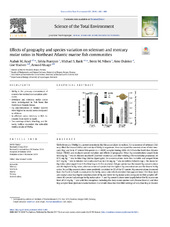| dc.contributor.author | Azad, Atabak Mahjour | |
| dc.contributor.author | Frantzen, Sylvia | |
| dc.contributor.author | Bank, Michael | |
| dc.contributor.author | Nilsen, Bente Merete | |
| dc.contributor.author | Duinker, Arne | |
| dc.contributor.author | Madsen, Lise | |
| dc.contributor.author | Måge, Amund | |
| dc.date.accessioned | 2019-09-10T09:32:50Z | |
| dc.date.available | 2019-09-10T09:32:50Z | |
| dc.date.issued | 2019-11-01 | |
| dc.Published | Mahjour Azad AA, Frantzen S, Bank M, Nilsen Bm, Duinker A, Madsen L, Måge A. Effects of geography and species variation on selenium and mercury molar ratios in Northeast Atlantic marine fish communities. Science of the Total Environment. 2019;652:1482-1496 | eng |
| dc.identifier.issn | 1879-1026 | en_US |
| dc.identifier.issn | 0048-9697 | en_US |
| dc.identifier.uri | https://hdl.handle.net/1956/20812 | |
| dc.description.abstract | Methylmercury (MeHg) is a potent neurotoxin that bioaccumulates in seafood. Co-occurrence of selenium (Se) may affect the bioavailability and toxicity of MeHg in organisms. Here we report the concentrations of total mercury (Hg) and Se in 17 teleost fish species (n = 8459) sampled during 2006–2015 from the North East Atlantic Ocean (NEAO) and evaluate species variation and effects of geography. Mean Hg concentration ranged from 0.04 mg kg−1 ww in Atlantic mackerel (Scomber scombrus) and blue whiting (Micromesistius poutassou) to 0.72 mg kg−1 ww in blue ling (Molva dypterygia). Se concentrations were less variable and ranged from 0.27 mg kg−1 ww in Atlantic cod (Gadus morhua) to 0.56 mg kg−1 ww in redfish (Sebastes spp.). The mean Se:Hg molar ratio ranged from 1.9 in blue ling to 43.3 in mackerel. Pelagic species had the lowest Hg concentrations and the highest Se:Hg ratios, whereas demersal species had the highest Hg concentrations and the lowest Se:Hg ratios. Se and Hg concentrations were positively correlated in 13 of the 17 species. Hg concentrations increased from the North to South in contrast to the Se:Hg molar ratio which exhibited the opposite trend. Fish from fjord and coastal areas had higher concentrations of Hg and lower Se:Hg molar ratios compared to fish sampled offshore. All species had average Se:Hg molar ratios >1 and Hg concentrations were largely below the EU maximum level of 0.5 mg kg−1 ww with few exceptions including the deep water species tusk (Brosme brosme) and blue ling sampled from fjord and coastal habitats. Our results show that two fillet servings of tusk, blue ling or Atlantic halibut (Hippoglossus hippoglossus) exceeded the tolerable weekly intake of MeHg although the surplus Se may possibly ameliorate the toxic effects of MeHg. However, some individuals with selenium deficiencies may exhibit greater sensitivity to MeHg. | en_US |
| dc.language.iso | eng | eng |
| dc.publisher | Elsevier | en_US |
| dc.rights | Attribution CC BY | eng |
| dc.rights.uri | https://creativecommons.org/licenses/by/4.0/ | eng |
| dc.subject | Mercury | eng |
| dc.subject | Selenium | eng |
| dc.subject | Marine | eng |
| dc.subject | Norway | eng |
| dc.subject | Seafood safety | eng |
| dc.title | Effects of geography and species variation on selenium and mercury molar ratios in Northeast Atlantic marine fish communities | en_US |
| dc.type | Peer reviewed | |
| dc.type | Journal article | |
| dc.date.updated | 2019-06-05T11:51:17Z | |
| dc.description.version | publishedVersion | en_US |
| dc.rights.holder | Copyright 2018 The Authors | en_US |
| dc.identifier.doi | https://doi.org/10.1016/j.scitotenv.2018.10.405 | |
| dc.identifier.cristin | 1693111 | |
| dc.source.journal | Science of the Total Environment | |

